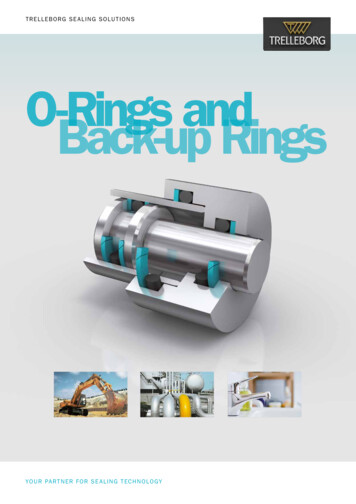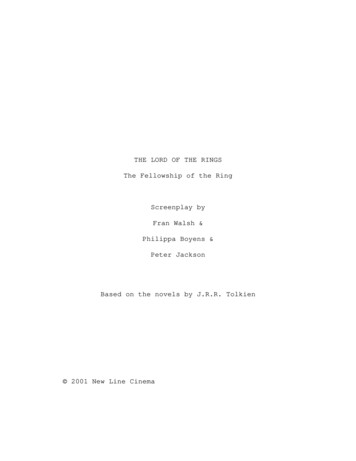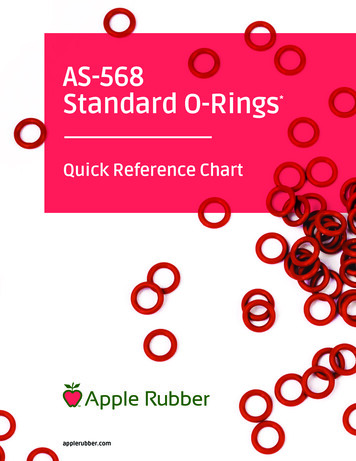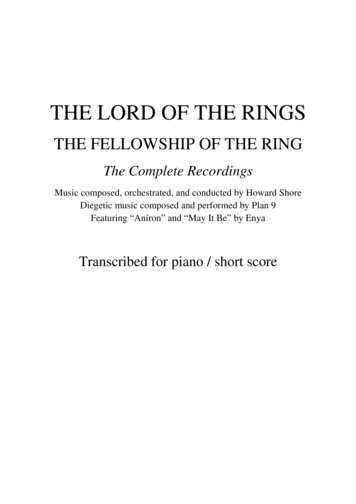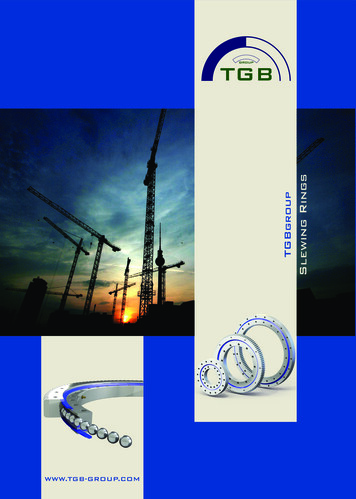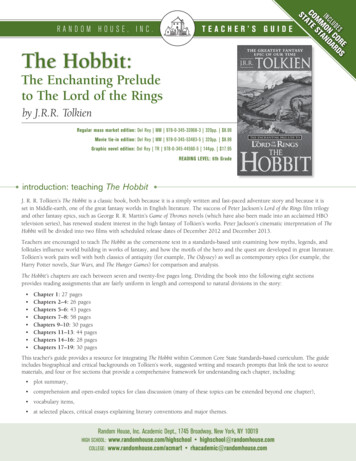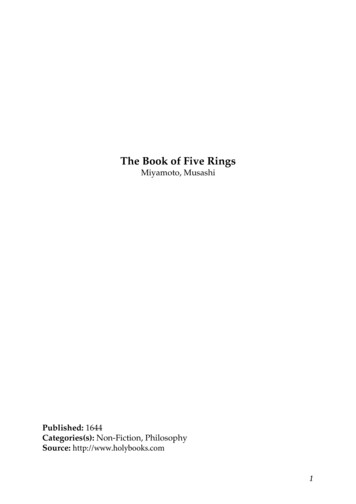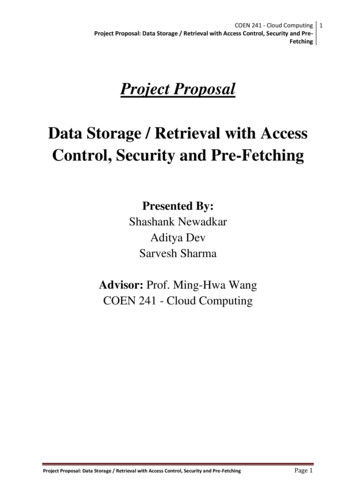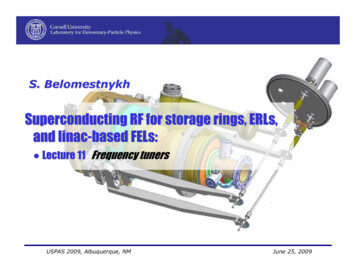
Transcription
S. BelomestnykhSuperconducting RF for storage rings, ERLs,and linac-based FELs: Lecture 11 Frequency tunersUSPAS 2009, Albuquerque, NMJune 25, 2009
Frequency tuner functions & designissuesWhy do SRF cavities need frequency tuners? Tune cavity resonance to operating frequency after cool-downActively compensate reactive part of beam loadingDetune cavity on purpose for bypass operationFind resonance after RF tripsCompensate slow frequency driftCompensate static Lorentz force detuning (CW operation)Compensate dynamic Lorentz force detuning (in pulsed machines)Compensate microphonics (in CW-machines)Design issues June 25, 2009long lifetimetuner resolutioncompactlow hysteresis / backlashlimit range to avoid plastic deformation of the cavitylimit cross-talk to neighboring cavitieslimit cryogenic heat loadprovide serviceabilityUSPAS 2009, S. Belomestnykh, Lecture 12: Tuners2
Frequency tuner types Mechanical length change or other deformation of the cavity based on a motor driven mechanism (slow/coarse) compensate slow He pressure fluctuationsand beam loading; two versions: 1) warm motor lever tuning plate large size, but goodserviceability; 2) cold motor compact; wide tuning range of several 100 kHz, required resolutionis 1 Hz. Typical sensitivity is 500 Hz/µµm. based on PZT or magnetostrictive element (fast) compensate microphonics and LF detuning inpulsed machines; still under development; narrow tuning range (several cavity bandwidths), butfast response ( 1 kHz). thermal tuners (LEP). VXC (external reactance) or ferrite based tuner Other: Pneumatic, thermal, electronic dampingNote: Tuners which control in addition to frequency also loaded Q and incident phase arepossible (three stub tuner).We will review only mechanical tuners as this is the only type used in high-β cavities.Many tuners incorporate piezo elements for fast tuning.June 25, 2009USPAS 2009, S. Belomestnykh, Lecture 12: Tuners3
Mechanical tuners Many tuners were developed over the years, but it seems that every mechanical engineerwants to develop his/her own design. We will consider how a tuner works using one example and then review several other designs.June 25, 2009USPAS 2009, S. Belomestnykh, Lecture 12: Tuners4
TTF (Saclay I) tunerJune 25, 2009USPAS 2009, S. Belomestnykh, Lecture 12: Tuners5
TTF tuner with piezoJune 25, 2009USPAS 2009, S. Belomestnykh, Lecture 12: Tuners6
TTF tuner with piezo (2)lever systempiezospindleflextureHe vesselModified piezo holder frame:higher wall thicknessJune 25, 2009USPAS 2009, S. Belomestnykh, Lecture 12: Tuners7
Saclay II tuner More compact460 kHz tuning range4 nm resolution 1.2 Hz1.4 kHz piezo tuning rangeJune 25, 2009USPAS 2009, S. Belomestnykh, Lecture 12: Tuners8
Saclay II tuner (2)eccentricspindlepiezoflextureJune 25, 2009USPAS 2009, S. Belomestnykh, Lecture 12: TunersHe vessel9
Blade tunerTuner specs: 1 mm fine tuning (on cavity) F on all piezo (sum) 3.5 kN 1 kHz fast tuning 3 µm cavity displacement 4 µm piezo displacement 4 µm piezo displacement F on all piezo 11.0 N 1 Hz resolutionMechanism – all components are cold, in vacuum: Titanium frame Attaches to helium vessel shell Pre-tune using bolts pushing on shell rings Dicronite coating on bearings and drive screw Cavity tuned in tension or compression – blades provide axial deflectionJune 25, 2009USPAS 2009, S. Belomestnykh, Lecture 12: Tuners10
Blade tuner variations1st DESY prototype (Kaiser, Peters)ILC version (Pagani)Blade tuner occupies no beam linespace: it is mounted on top of the Hevessel. Can be used where beam linereal estate is at premium.Cornell ERL injectorpiezos Modification of the INFN blade tuner Added piezos for microphonics compensationJune 25, 2009USPAS 2009, S. Belomestnykh, Lecture 12: Tuners11
CEBAF Upgrade tuner Scissor jack mechanism- Ti-6Al-4V Cold flexures & fulcrum bars- Cavity tuner in tension only- Attaches on hubs of cavity Warm transmission- Stepper motor, harmonic drive, ball screw and piezo mounted on top of CM- Openings required in shielding and vacuum tank No bellows between cavities- Need to accomodate thermal contraction of cavity string- Pre-load and offset each tuner while warmJune 25, 2009USPAS 2009, S. Belomestnykh, Lecture 12: Tuners12
Coaxial ball screw tuner (KEK) Design objectives- Provide large tuning range while maintainingstiffness- 10 um fast tuning stroke for 3 kHz Lorentzh forcedetuning at 45 MV/m Warm transmission- Stepper motor, harmonic drive, ball screw andpiezo mounted on top of CM- Openings required in shielding and vacuum tank No bellows between cavities- Need to accomodate thermal contraction of cavitystring- Pre-load and offset each tuner while warmJune 25, 2009USPAS 2009, S. Belomestnykh, Lecture 12: Tuners13
Slide jack tuner (KEK)June 25, 2009USPAS 2009, S. Belomestnykh, Lecture 12: Tuners14
Comparison of tunersDesignSaclay ISaclay IIBlade TunerJLabupgradeKEK slide jackKEK coaxial ballscrewMotor tuningrange750 kHz460 kHz550 kHz500 kHz1100 kHz 4000 kHzSlow resolution0.75 Hz1.2 Hz 1 Hz 1 Hz 100 Hz 120 HzMotorhysteresissatisfyingbacklashproblems atlow amplitudessatisfyingTransmissionlocation5 K, vacuum5 K, vacuum5 K, vacuumRT, airRT, air80 K, vacuumNumber ofpiezo elements1-222-4211Piezo tuningrange840 Hz1420 Hz1400 Hz1000 Hz1900 Hz2500 HzGroup delay360 µs150 µs650 µsStiffnesslowerhigherlowestLowestresonance40 Hz40 Hz35 HzPiezo location5 K, vacuum5 K, vacuum5 K, vacuumRT, airRT, air80 K, vacuumJune 25, 2009USPAS 2009, S. Belomestnykh, Lecture 12: Tuners15
Dynamic Lorentz-force detuning in TTFpower [kW]accelerating gradient [MV/m]accelerating phase [5 deg]detuning [20 Hz]Example: TTF cavity at 35 MV/m (simulation)additional RF powerDetuningtimeJune 25, 2009withoutdetuningtimeUSPAS 2009, S. Belomestnykh, Lecture 12: Tuners16
Lorentz-force detuningcompensationamplitude [arb. units]TESLA 9-cell cavity at 23.5 MV/m with 10 Hz repetition rate:gradienttime dependent gradient time dependent detuningtime [µµs]June 25, 2009USPAS 2009, S. Belomestnykh, Lecture 12: Tuners17
Tuner featuresCoarse tuners (stepping motor) Typically cold, must be reliable and maintainable access ports Direct cavity drive reduces stiffness requirements on helium vessel Tuner / Helium vessle stiffness should be approximately factor of 10 higher than cavity stiffness Flexures exhibit reduced backlash Typically tune in tension or compression to avoid “dead band” Cold transmision: Materials considerations (lubrication, vacuum); Access for repair orreplacement; Electrical feedthroughs Warm transmission: Cooldown/tuning compliance; Port for transmission; BellowsPiezo tuners Operate in compression Warm range is 5 to 10 time larger than cold range Capacitive device: Low vs. High voltage (stiffer) Shorter piezos: reduce hysteresis; stiffer, but reduced tuning rangeJune 25, 2009USPAS 2009, S. Belomestnykh, Lecture 12: Tuners18
What have we learned? Frequency tuner designs have advanced significantly during during the last decade tomeet the needs of the high gradient and/or pulsed superconducting accelerators. A variety of technologies are available for cavity tuner designs. However combinedstepper motor and piezo tuning is the method of choice for high-β cavities. Important design considerations: frequency resolution; compactness;hysteresis/backlash; cold vs warm transmission; reliability; ease of maintenance; cost. Next lecture: cavity fabrication, preparation and testing.June 25, 2009USPAS 2009, S. Belomestnykh, Lecture 12: Tuners19
Scissor jack mechanism - Ti-6Al-4V Cold flexures & fulcrum bars - Cavity tuner in tension only - Attaches on hubs of cavity Warm transmission - Stepper motor, harmonic drive, ball screw and piezo mounted on top of CM - Openings required in shielding and vacuum tank No bellows between cavities - Need to accomodate thermal contraction of cavity string - Pre-load and offset each tuner .
